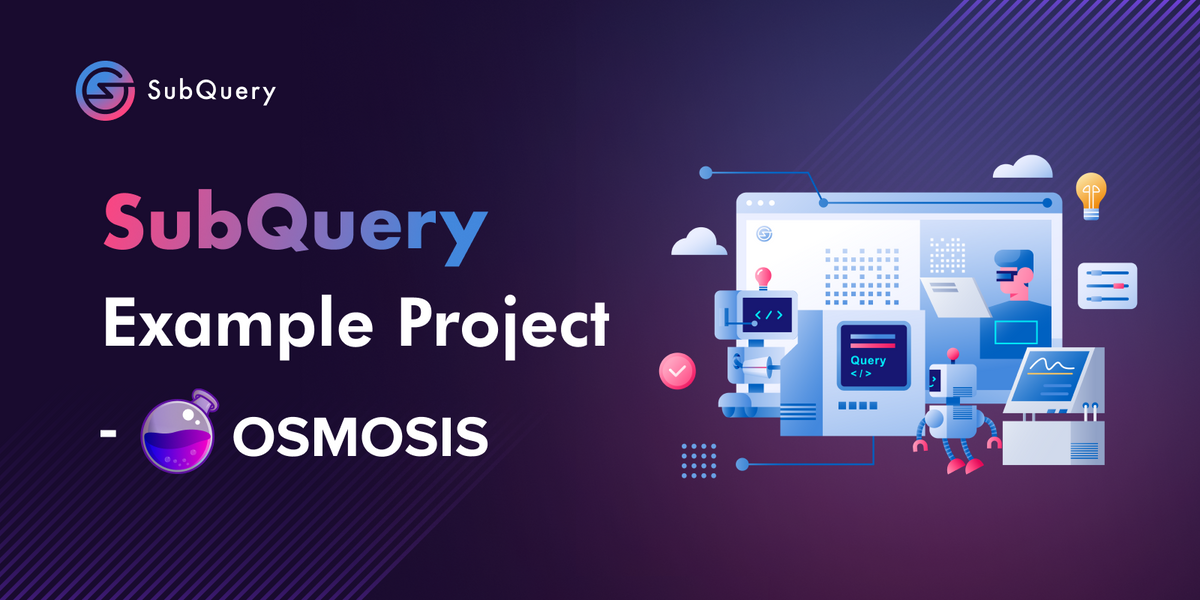In the ever-expanding world of blockchain and DeFi, the Osmosis project stands as a prime example of innovation within the Cosmos ecosystem. Setting up an indexer for Osmosis is a vital step for those looking to dive into its thriving Cosmos DeFi landscape.
In this comprehensive article, we present a detailed, user-friendly guide on configuring a SubQuery indexer for Osmosis. Our aim is to demystify the entire procedure, ensuring it's accessible to users of all skill levels. This guide serves as your pathway to effectively handling swap data from a well-known project like Osmosis.
We delve into the intricacies of Cosmos message handlers and harness the power of the SubQuery SDK's type generation capabilities to easily access the parameters of each message. Whether you're an experienced developer or just embarking on your journey, this guide empowers you with the knowledge and confidence needed to navigate the Osmosis ecosystem seamlessly.
Example
The Osmosis sample project meticulously gathers data related to Swaps, the pathways within these swaps, and the pools that play a role in these pathways.
Key resources:
We've also got a pre-recorded workshop for this sample project, making it easier to stay updated and grasp its complexities:
Marta Adamczyk (Subquery) - Cosmos Data Indexing Made Easy with SubQuery
Use-Cases
Upon running the project, you gain the capability to execute queries. Using an entity called 'Swap' connected with other entities such as 'SwapRoute' and 'Pools,' you can easily retrieve information from all of them with a single query, thanks to a shared parent entity. This functionality is illustrated in the following example:
With this query, you can retrieve information about the first swap in the dataset, including the sender's address and the amount involved, and other key data like the transaction hash and block height. It also dives into the specific routes within the swap, revealing unique IDs, associated pool details, and more. This simple query structure is a valuable resource for understanding the inner workings of Osmosis. You can compare the data retrieved using this query with the information available on Osmosis explorer, such as in this example: https://bigdipper.live/osmosis/transactions/01266C84314757710593EF3E215990B842706FEF905ABD539420FD12A39A0AD3.
In summary, SubQuery's SDK makes it easy for developers to get data from Osmosis swaps, showcasing its potential. This shows how developers can smoothly integrate on-chain data for practical applications. Whether you're building tools to analyse Osmosis swaps or creating dApps for DeFi data, SubQuery's SDK is the right tool for the job.
About Osmosis
Osmosis, operating within the Cosmos ecosystem, functions as a DEX. Its primary purpose is to facilitate the exchange of tokens across various blockchains within the Cosmos network. Osmosis leverages the IBC protocol to facilitate the seamless transfer of assets among different blockchains, which may include Cosmos Hub, Akash, and other compatible chains.
About SubQuery
SubQuery is a leading blockchain data indexer that provides developers with fast, flexible, universal, and decentralised APIs for web3 projects. We empower developers from over 110+ ecosystems including Ethereum, Polygon, Polkadot, Cosmos, Algorand, NEAR, and Avalanche with rich indexed data to allow them to build intuitive and immersive decentralised applications. This blockchain developer toolkit enables developers to focus on their core use case and front-end without wasting time building a custom backend for data processing activities. In the near future, the SubQuery Network will replicate this scalable and reliable solution in a completely decentralised manner.

